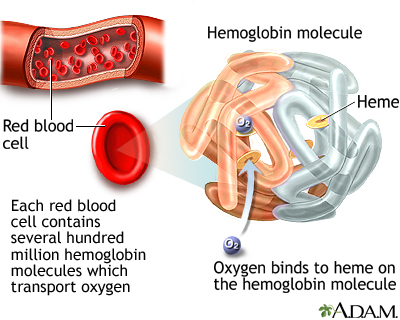Health Library
Hemoglobin
Hgb; Hb; Anemia - Hb; Polycythemia - Hb
Hemoglobin is a protein in red blood cells that carries oxygen. The hemoglobin test measures how much hemoglobin is in your blood.
Images

I Would Like to Learn About:
How the Test is Performed
A blood sample is needed.
How to Prepare for the Test
No special preparation is necessary.
How the Test will Feel
When the needle is inserted to draw blood, some people feel moderate pain. Others feel only a prick or stinging. Afterward, there may be some throbbing or a slight bruise. This soon goes away.
Why the Test is Performed
The hemoglobin test is a common test and is almost always done as part of a complete blood count (CBC). Reasons or conditions for ordering the hemoglobin test include:
- Before and after major surgery
- Blood in your stools, or vomit (if you throw up)
- Chronic medical problems, such as kidney disease or certain types of arthritis
- During pregnancy
- Fatigue, poor health, or unexplained weight loss
- Headaches
- Heavy menstrual periods
- Leukemia or other problems in the bone marrow
- Monitoring during treatment for cancer
- Monitoring medicines that may cause anemia or low blood counts
- Monitoring of anemia and its cause
- Poor nutrition
- Problems concentrating
Normal Results
Normal results for adults vary, but in general are:
- Male: 13.8 to 17.2 grams per deciliter (g/dL) or 138 to 172 grams per liter (g/L)
- Female: 12.1 to 15.1 g/dL or 121 to 151 g/L
Normal results for children vary, but in general are:
- Newborn: 14 to 24 g/dL or 140 to 240 g/L
- Infant: 9.5 to 13 g/dL or 95 to 130 g/L
The ranges above are common measurements for results of these tests. Normal value ranges may vary slightly among different laboratories. Some labs use different measurements or test different samples. Talk to your health care provider about the meaning of your specific test results.
What Abnormal Results Mean
LOWER THAN NORMAL HEMOGLOBIN
Low hemoglobin level may be due to:
- Anemia
- Bleeding
- Bone marrow being unable to produce new red blood cells. This may be due to leukemia, other cancers, drug toxicity, radiation therapy, infection, or bone marrow disorders
- Chronic illness
- Chronic kidney disease
- Destruction of red blood cells (hemolysis)
- Leukemia
- Malnutrition
- Too little iron, folate, vitamin B12, and vitamin B6 in the diet
- Too much water in the body
HIGHER THAN NORMAL HEMOGLOBIN
High hemoglobin level is most often caused by low oxygen levels in the blood (hypoxia), present over a long period of time. Common reasons include:
- Bone marrow disease that causes abnormal increase in red blood cells (polycythemia vera)
- Congenital heart disease
- Exposure to high altitude
- Failure of the right side of the heart
- Low levels of oxygen in the blood
- Scarring or thickening of the lungs
- Too little water in the body (dehydration)
Risks
There is little risk involved with having your blood taken. Veins and arteries vary in size from one person to another and from one side of the body to the other. Obtaining a blood sample from some people may be more difficult than from others.
Other risks associated with having blood drawn are slight, but may include:
- Excessive bleeding
- Fainting or feeling lightheaded
- Multiple punctures to locate veins
- Hematoma (blood buildup under the skin)
- Infection (a slight risk any time the skin is broken)
Related Information
CBC blood testHemoglobin electrophoresis
Anemia
Erythropoietin test
Hemolysis
Hemolytic transfusion reaction
Bleeding
Lead poisoning
Malnutrition
Folic acid in diet
Vitamin B12
Vitamin B6
Cor pulmonale
Idiopathic pulmonary fibrosis
Polycythemia vera
Anemia of chronic disease
Hemoglobin C disease
Diabetes
Giant cell arteritis
Glucose-6-phosphate dehydrogenase deficiency
Type 1 diabetes
Aplastic anemia
Immune hemolytic anemia
Iron deficiency anemia
Paroxysmal cold hemoglobinuria (PCH)
Paroxysmal nocturnal hemoglobinuria (PNH)
Pernicious anemia
Placenta abruption - definition
Polymyalgia rheumatica
Rhabdomyolysis
Drug-induced immune hemolytic anemia
References
Chernecky CC, Berger BJ. Hemoglobin (HB, Hgb). In: Chernecky CC, Berger BJ, eds. Laboratory Tests and Diagnostic Procedures. 6th ed. Philadelphia, PA: Elsevier; 2013:621-623.
Marcdante KJ, Kliegman RM, Schuh AM. Hematology assessment. In: Marcdante KJ, Kliegman RM, Schuch AM, eds. Nelson Essentials of Pediatrics. 9th ed. Elsevier; 2023:chap 149.
Means RT. Approach to the anemias. In: Goldman L, Schafer AI, eds. Goldman-Cecil Medicine. 26th ed. Philadelphia, PA: Elsevier; 2020:chap 149.
BACK TO TOPReview Date: 1/9/2022
Reviewed By: David C. Dugdale, III, MD, Professor of Medicine, Division of General Medicine, Department of Medicine, University of Washington School of Medicine. Also reviewed by David Zieve, MD, MHA, Medical Director, Brenda Conaway, Editorial Director, and the A.D.A.M. Editorial team.
 | A.D.A.M., Inc. is accredited by URAC, for Health Content Provider (www.urac.org). URAC's accreditation program is an independent audit to verify that A.D.A.M. follows rigorous standards of quality and accountability. A.D.A.M. is among the first to achieve this important distinction for online health information and services. Learn more about A.D.A.M.'s editorial policy, editorial process and privacy policy. A.D.A.M. is also a founding member of Hi-Ethics. This site complies with the HONcode standard for trustworthy health information: verify here. |
The information provided herein should not be used during any medical emergency or for the diagnosis or treatment of any medical condition. A licensed medical professional should be consulted for diagnosis and treatment of any and all medical conditions. Links to other sites are provided for information only -- they do not constitute endorsements of those other sites. © 1997- 2022 A.D.A.M., a business unit of Ebix, Inc. Any duplication or distribution of the information contained herein is strictly prohibited.
